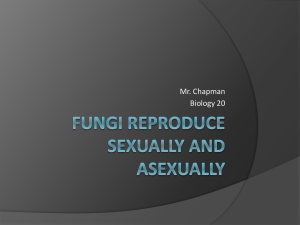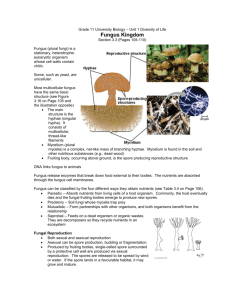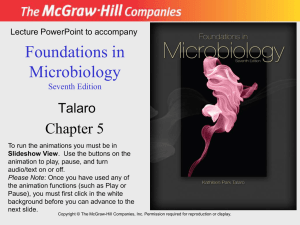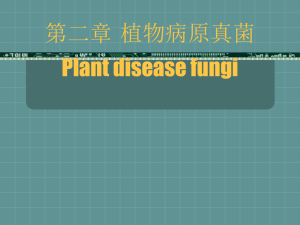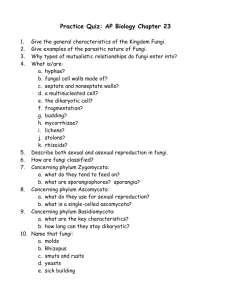Fungi Fungi are eukaryotic organisms that do not contain chlorophyll
advertisement
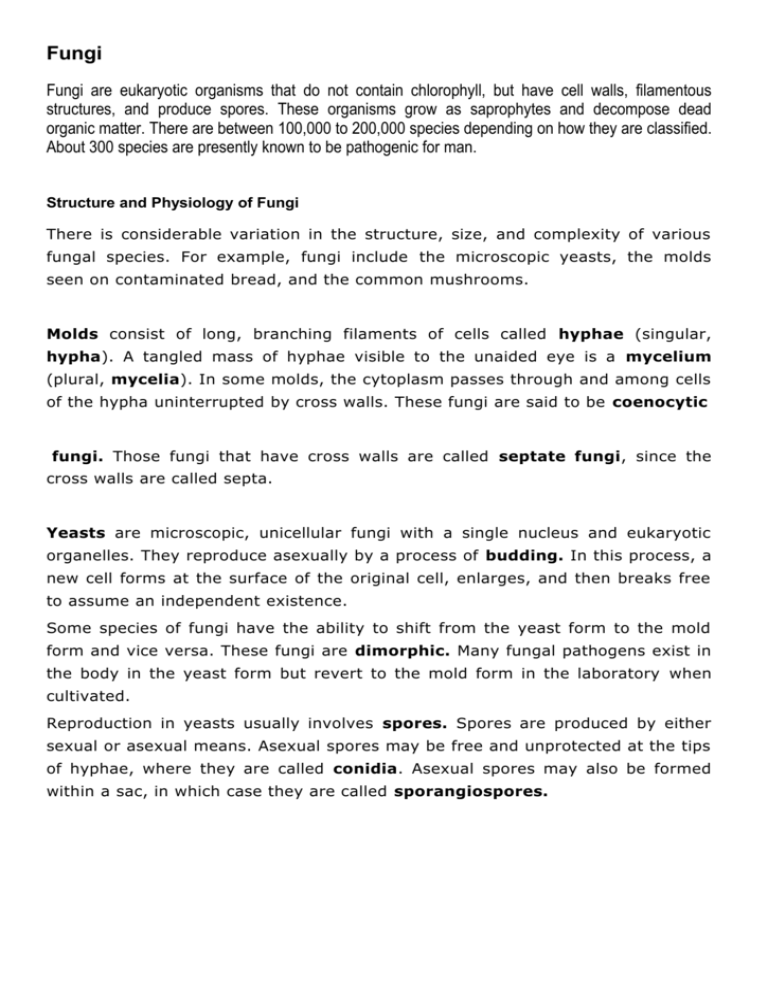
Fungi Fungi are eukaryotic organisms that do not contain chlorophyll, but have cell walls, filamentous structures, and produce spores. These organisms grow as saprophytes and decompose dead organic matter. There are between 100,000 to 200,000 species depending on how they are classified. About 300 species are presently known to be pathogenic for man. Structure and Physiology of Fungi There is considerable variation in the structure, size, and complexity of various fungal species. For example, fungi include the microscopic yeasts, the molds seen on contaminated bread, and the common mushrooms. Molds consist of long, branching filaments of cells called hyphae (singular, hypha). A tangled mass of hyphae visible to the unaided eye is a mycelium (plural, mycelia). In some molds, the cytoplasm passes through and among cells of the hypha uninterrupted by cross walls. These fungi are said to be coenocytic fungi. Those fungi that have cross walls are called septate fungi, since the cross walls are called septa. Yeasts are microscopic, unicellular fungi with a single nucleus and eukaryotic organelles. They reproduce asexually by a process of budding. In this process, a new cell forms at the surface of the original cell, enlarges, and then breaks free to assume an independent existence. Some species of fungi have the ability to shift from the yeast form to the mold form and vice versa. These fungi are dimorphic. Many fungal pathogens exist in the body in the yeast form but revert to the mold form in the laboratory when cultivated. Reproduction in yeasts usually involves spores. Spores are produced by either sexual or asexual means. Asexual spores may be free and unprotected at the tips of hyphae, where they are called conidia. Asexual spores may also be formed within a sac, in which case they are called sporangiospores. Figure 1 The microscopic structures of a septate fungus showing asexually producedconidia that leave the fungus and germinate to produce a new mycelium. Nutrition. Fungi grow best where there is a rich supply of organic matter. Most fungi are saprobic (obtaining nutrients from dead organic matter). Since they lack photosynthetic pigments, fungi cannot perform photosynthesis and must obtain their nutrients from preformed organic matter. They are therefore chemoheterotrophic organisms. Most fungi grow at an acidic pH of about 5.0, although some species grow at lower and higher pH levels. Most fungi grow at about 25°C (room temperature) except for pathogens, which grow at 37°C (body temperature). Fungi store glycogen for their energy needs and use glucose and maltose for immediate energy metabolism. Most species are aerobic, except for the fermentation yeasts that grow in both aerobic and anaerobic environments. Fungal Reproduction Fungi exhibit three major modes of reproduction - vegetative, asexual and sexual. Vegetative Reproduction It is the type of reproduction which involves the somatic portion of the fungal thallus. It occurs by the following methods. Fragmentation In this process, the mycelium breaks into two or more similar fragments either accidentally or due to some external force. Each fragment grows into a new mycelium. Budding The parent cell produces one or more projections called buds, which later develop necessary structures and detach to grow into new individuals. Budding is common in unicellular forms like yeast. Fission In this process, the parent cell splits into two equal halves, each of which develop into a new individual. Fission is also common in yeast. Sclerotia In some cases, as in Claviceps, the hyphae become interwoven to form a compact mass and get surrounded by a hard covering or rind. Such structures are called SCLEROTIA. They remain dormant under unfavourable conditions and germinate into new mycelia on the return of favourable conditions. Rhizomorphs In some higher fungi, several hyphae may become interwoven to form rope-like structures called rhizomorphs. Under favourable conditions, they resume growth to give rise to new mycelia. fig. 8.19 - Modes of Vegetative Reproduction Asexual Reproduction It is the type of reproduction in which special reproductive structures called spores or propagates are formed. The fungal spores always result from mitosis and hence are described as mitospores. Following are the types of spores produced in different groups of fungi: Zoospores They are flagellated, motile spores produced inside structures called zoosporangia. These spores do not have a cell wall. Such spores are produced in lower fungi such as Achyla and Saprolegnia. Sporagiospores These are non-motile spores produced inside structures called sporangia in fungi such as Rhizopus and Mucor. These spores are dispersed by wind. fig. 8.20 - Modes of Asexual Reproduction Chlamydospores These are thick walled resting spores which arise directly from hyphal cells. They store reserve food. Oidia These are spore like structures formed by the breaking up of hypha cells. They do not store reserve food and hence cannot survive under unfavourable conditions. Such spores are produced in Rhizopus. Conidia These are non-motile spores produced singly or in chains at the tip of the hypha branches that are called conidiophores. Such spores are produced in fungi like Aspergillus and Penicillium. Sexual Reproduction Sexual reproduction is known to occur in all groups of fungi except the Fungi imperfecti or Dueteromycetes. It may involve fusion of gametes, gametangia or hyphae. The process may involve only fusion of cytoplasm (plasmogamy) or fusion of nuclei (karyogamy) or production of meiotic spores (meiospores) In most of the lower fungi plasmogamy is immediately followed by karyogamy and meiosis. In higher fungi karyogamy is often delayed so that the hyphae remain dikaryotic. This phase of fungal life cycle is called dikaryophase. Such fungi complete their life cycle in three phases a haplophase, a dikaryophase and a diplophase. Sexual fusion in fungi is of different types, as follows : Planogametic Copulation Here motile gametes called planogametes undergo fusion. When both the gametes are motile and morphologically similar, the fusion process is called isogamy. Eg.: Synchytrium When both the gametes are motile but differ in their size, the fusion process is called anisogamy. Eg.: Allomyces. When one gamete (male) is smaller and motile and the other (female) gamete is larger and non motile, the fusion process is called heterogamy. Gametangial Contact Here, gamete bearing structures called gametangia come closer to each other and develop a fertilisation tube through which the male gamete migrates into the female gametangium. Eg. : Phytophthora, Albugo. Gametangial Copulation Here, the gametangia fuse with each other, lose their identity and develop into a zygospore Eg.: Mucor, Rhizopus Spermatisation In some fungi like Puccinia, tiny unicellular spore like structures called spermatia are formed. They get transferred to female gametangia through various agencies. fig. 8.21 - Types of Sexual Reproduction in Fungi



